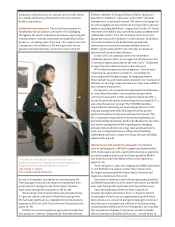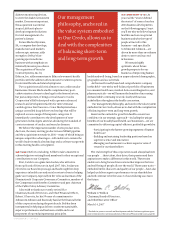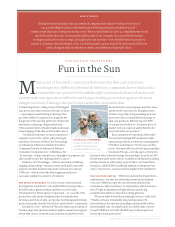Johnson and Johnson 2006 Annual Report Download - page 18
Download and view the complete annual report
Please find page 18 of the 2006 Johnson and Johnson annual report below. You can navigate through the pages in the report by either clicking on the pages listed below, or by using the keyword search tool below to find specific information within the annual report.
J O H N S O N & J O H N S O N 2 0 0 6 A N N U A L R E P O R T
Throughout history, some of humanity’s worst enemies have been infectious
diseases caused by microbes—one-celled or small multicelled life forms.
“Infectious diseases caused by bacteria and viruses have been one of
the most important causes of mortality for centuries and continue to be a medical
challenge,” says Paul Stoffels, M.D., Company Group Chairman, Research and
Development, CNS (Central Nervous System) and Internal Medicine, and founder
of Tibotec-Virco, a company acquired in 2002 that specializes in new treatments
for viral infections. “The most widely spread epidemics are called pandemics.
One of the deadliest has been HIV, which since 1981 has infected an estimated
60 million people, killing 25 million of them.”
The year 2006 was a milestone in science’s battle against
HIV: “It has been 25 years since the first case of AIDS, then
unnamed, was reported to the Centers for Disease Control,”
says Stoffels, who has dedicated much of his career to battling
the world’s most lethal viruses. “It has been 20 years since
the first clinical trial of antiretroviral drugs, which inhibit
HIV genetic material in the patient’s blood. And it has been
10 years since the debut of the first protease inhibitors,
which prevent the virus from creating as many as 1 billion
new copies daily in an HIV-positive patient.”
NEW PROT E A S E I N H I B I TOR Moreover, 2006 was the year that
a Johnson & Johnson operating company launched—in record
time—a new protease inhibitor (PI) for patients who have
failed previous therapies, such as another PI. The new drug,
PREZISTA™ (darunavir), also known as TMC114, is marketed
in the U.S. by Tibotec Therapeutics Division of Ortho Biotech
Products, LP, and in other countries by the Tibotec divisions
within the Janssen-Cilag companies. It signals the start of a
new global virology business franchise for Johnson & Johnson.
The franchise’s pipeline is robust with other novel investi-
gational medications for HIV, for hepatitis C (HCV) and for
tuberculosis (TB). TB is one of the most important opportu-
nistic infections in HIV patients throughout the world.
“Global infectious diseases are among the greatest unmet
medical challenges of our generation,” says Julie McHugh,
Company Group Chairman, Virology. “Infectious diseases like
HIV, HCV and TB are truly global health issues. They require
the pharmaceutical industry to create innovative solutions,
not only by developing new best-in-class compounds
but also by bringing these medications to the patients who need
them in both industrialized and developing countries. Because
our innovative science addresses such urgent needs, we believe
we have the opportunity to build a new sustainable business
while having a real impact on epidemics worldwide.”
UNIQUE R&D PROCESS PREZISTA™ is the result of a unique
pharmaceutical research and development process that relied
on HIV drug-resistance insights gleaned from diagnostic tools
pioneered by Virco, an affiliate of Tibotec. Virco performed
diagnostic tests to chart, on a molecular level, up to 250,000
types of resistant HIV viruses worldwide; Tibotec then used
the information to design a molecule that would be able
to inhibit replication of the most prevalent drug-resistant
strains of the virus.
“But beyond resistance, to truly benefit patients we also
had to be concerned with efficacy, safety, tolerability and conve-
nience. PREZISTA™ is an important new option for treatment
O U R P A S S I O N T R A N S F O R M S :
Humans vs. Microbes
16
Imaging
technology
portrays humanity’s
worst enemies—
in this case, HIV—
in astounding
detail.
Until AIDS,
tuberculosis was
the leading cause
of death from
infectious disease
worldwide.
Globally, some
170 million
people are
infected with
the hepatitis C
virus (HCV).
























